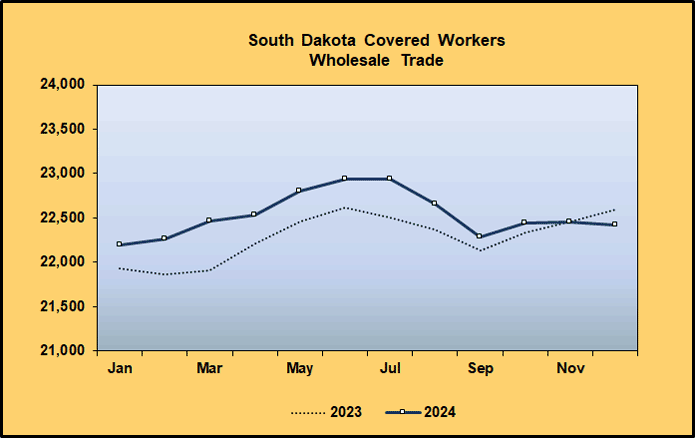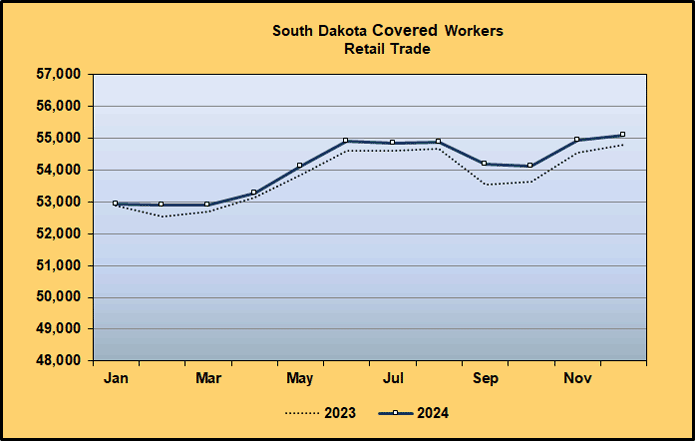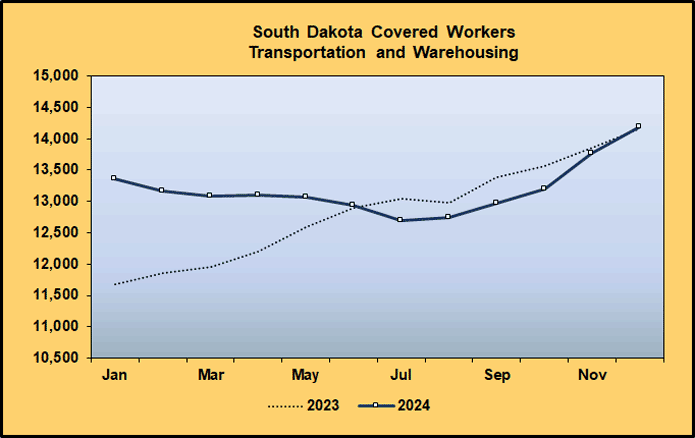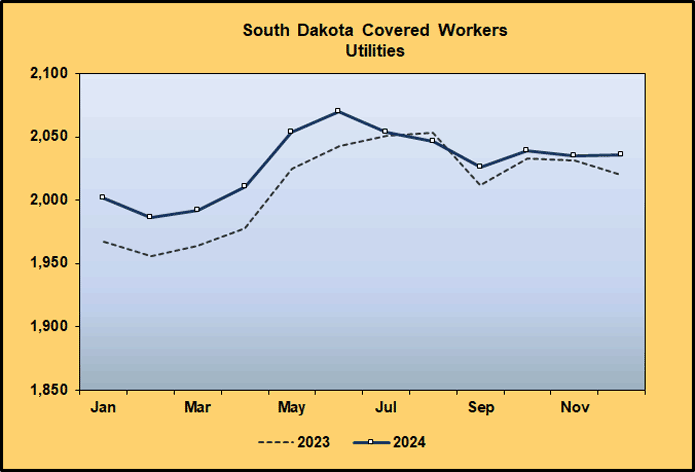- Home to LMIC
- Virtual Labor Market Data System
- Career Exploration & Planning
- Consumer Price Index
- Demographics
- Economic Snapshot
- Employee Benefits
- Employment Projections
- Labor Force & Unemployment
- Labor Supply
- Overview of the Current Labor Market
- Surveys We Conduct
- Wages & Income
- Workers by Industry
- Tools & Resources
- Publications
- References
- What's New
- Can't Find It?
Labor Market Information Center
2024 Annual Report
Quarterly Census of Employment and Wages
Trade, Transportation and Utilities Supersector
The Trade, Transportation and Utilities supersector is comprised of the Wholesale Trade sector, the Retail Trade sector, the Transportation and Warehousing sector and the Utilities sector. Businesses within this supersector sell or arrange the sale of goods and supplies and retail merchandise to the public, provide transportation of passengers or cargo or generate and/or distribute electricity, gas or water.
| South Dakota Covered Workers and Pay 2024 |
|||
| Supersector, Sector and Subsector | Number of Establishments | Average Number of Workers | Annual Pay |
| Trade, Transportation and Utilities | 8,952 | 91,841 | $52,587 |
| Wholesale Trade | 3,305 | 22,532 | $82,766 |
| Merchant Wholesalers, Durable Goods | 1,749 | 11,452 | $88,850 |
| Merchant Wholesalers, Nondurable Goods | 1,392 | 10,630 | $74,650 |
| Wholesale Trade Agents and Brokers | 164 | 450 | $119,658 |
| Retail Trade | 3,959 | 54,087 | $37,589 |
| Motor Vehicle and Parts Dealers | 567 | 8,336 | $61,393 |
| Building Material and Garden Equipment and Supplies Dealers | 399 | 6,017 | $44,251 |
| Food and Beverage Retailers | 379 | 8,855 | $26,148 |
| Furniture, Home Furnishings, Electronics, and Appliance Retailers | 326 | 2,614 | $53,201 |
| General Merchandise Retailers | 277 | 9,953 | $31,012 |
| Health and Personal Care Retailers | 253 | 2,152 | $41,588 |
| Gasoline Stations and Fuel Dealers | 655 | 7,633 | $29,530 |
| Clothing, Clothing Accessories, Shoe, and Jewelry Retailers | 382 | 2,612 | $25,353 |
| Sporting Goods, Hobby, Musical Instrument, Book, and Miscellaneous Retailers | 721 | 5,916 | $32,903 |
| Transportation and Warehousing | 1,512 | 13,192 | $54,073 |
| Air Transportation | 31 | 78 | $103,071 |
| Truck Transportation | 1,052 | 4,849 | $63,916 |
| Transit and Ground Passenger Transportation | 78 | 1,284 | $28,932 |
| Pipeline Transportation | 19 | 136 | $124,073 |
| Scenic and Sightseeing Transportation | 14 | 107 | $30,141 |
| Support Activities for Transportation | 167 | 1,196 | $60,466 |
| Postal Service | 8 | 27 | $25,166 |
| Couriers and Messengers | 98 | 2,473 | $48,043 |
| Warehousing and Storage | 45 | 3,043 | $48,080 |
| Utilities | 176 | 2,029 | $107,609 |
| Utilities | 176 | 2,029 | $107,609 |
| Totals may not add due to rounding. Data subject to revision. Produced by the Labor Market Information Center, South Dakota Department of Labor and Regulation, in cooperation with the U.S. Bureau of Labor Statistics. |
|||
Wholesale Trade
NAICS Sector 42
Wholesale Trade worker levels in 2024 continued to climb for the fourth consecutive year in a row. The sector added 248 workers (1.1%), reaching 22,532 in 2024. Wholesale Trade is influenced by many factors, including technology advancements like increased automation, economic growth, and supply chains (nationally and worldwide). The average annual wage increased 3.7%, reaching $82,766 in 2024. The Wholesale Trade sector ranked sixth in annual pay and seventh in worker levels among all sectors in 2024.
Wholesale Trade establishments are engaged in wholesaling merchandise and rendering services incidental to the sale of merchandise. The merchandise described in this sector includes the outputs of agriculture, mining, manufacturing, and certain information industries, such as publishing. The wholesaling process in an intermediate step in the distribution of merchandise, as wholesalers sell merchandise to other businesses and normally operate from a warehouse or office.
Merchant Wholesalers, Durable Goods (NAICS 423) added the largest number of workers in the sector, increasing by 192 workers (1.7%) in 2024. Average annual pay increased $2,381 (2.8%). Durable goods are new or used items that have a normal life expectancy of three years or more. They include construction equipment, farm machinery, furniture, computer equipment, jewelry, and household appliances. The following four industry groups within the Merchant Wholesale, Durable Goods subsector experienced gains in both workers and annual pay from 2023 to 2024:
- Professional and Commercial Equipment and Supplies Merchant Wholesalers (NAICS 4234)
- Household Appliances and Electrical and Electronic Goods Merchant Wholesalers (NAICS 4236)
- Machinery, Equipment, and Supplies Merchant Wholesalers (NAICS 4238)
- Miscellaneous Durable Goods Merchant Wholesalers (NAICS 4239)
The Merchant Wholesalers, Nondurable Goods (NAICS 424) workforce expanded by 66 workers (0.6%) in 2024. Annual pay increased $3,463 (4.9%), reaching a 2024 average of $74,650. Establishments in this industry sell nondurable goods to other businesses. Nondurable goods generally have a life expectancy of less than three years. Examples include paper and paper products, farm products, drugs, petroleum, food, apparel, and newspapers. A majority of the worker levels gains within Merchant Wholesaler, Nondurable Goods took place in Miscellaneous Nondurable Goods Merchant Wholesalers (NAICS 4249). Those establishments sell on a wholesale basis products ranging from farm supplies and nursery stock to paint and varnish.
The last subsector in this industry is Wholesale Trade Agents and Brokers (NAICS 425). This subsector’s workforce took a small dip, declining by 11 workers (2.4%) in 2024. Average annual pay increased $6,269 (5.5%) from 2023 to 2024. This subsector has the highest annual pay out of the three Wholesale Trade subsectors with a 2024 wage of $119,658. The pay structure is usually salaried with distribution of bonuses and profits, resulting in some years with elevated pay. Brokers and agents in this subsector act on behalf of buyers or sellers of goods to facilitate wholesale trade.

Retail Trade
NAICS Sectors 44-45
Retail Trade worker levels trended up in 2024 for the fourth consecutive year. This sector added 294 workers (0.5%). Annual pay increased $749 (2.0%), reaching an annual average of $37,589. Retail Trade is ranked third out of all sectors in the number of establishments (3,959) and second in employment (54,087 workers). Establishments in Retail Trade employ many part-time workers, with many arranging their schedules around school, family needs, or another job. Six out of the nine Retail Trade subsectors had employment gains during 2024, and seven subsectors had increases in annual pay from 2023 to 2024.
Population growth and other sources of increased consumer demand impact worker levels in Retail Trade. Retailers have expanded their footprint in the state's growing communities. Many establishments have increased their social media presence and enhanced their offerings for consumer convenience (such as online ordering with in-store or curbside pick-up, or delivery) to help drive up consumer demand. When consumer spending increases, the demand for retail goods also grows, leading to more jobs in this sector.
General Merchandise Retailers (NAICS 455) added the largest number of workers with the addition of 374 workers (3.9%) from 2023 to 2024. With a total of 9,953 workers in 2024, the General Merchandise Retailers subsector accounted for 18.4% of the workforce in Retail Trade in 2024. The average annual pay increased $523 (1.7%). Department stores, supercenters, dollar stores, and general stores are the type of establishments included in this subsector.
Gasoline Stations and Fuel Dealers (NAICS 457) gained 195 workers (2.6%). Average annual pay increased $1,067 (3.7%). Gasoline service stations, truck stops, and gasoline stations with convenience stores are examples of establishments included in this subsector. Establishments in this subsector may also provide automotive repair services.
Sporting Goods, Hobby, Musical Instrument, Book, and Miscellaneous Retailers (NAICS 459) worker levels rose 1.7% with the addition of 100 workers. The average annual pay increased $1,718 (5.5%), jumping to $32,903. Industries in this subsector sell sporting equipment, musical instruments, and goods for other specific leisure activities. Sewing supply stores, sporting goods retailers, florists, bookstores, hobby shops, pet supply stores, and toy stores are examples of establishments included in this subsector.
Furniture, Home Furnishings, Electronics, and Appliance Retailers (NAICS 449) had loss of 179 workers (6.4%). Declines in this subsector may be related to drops in consumer spending on higher priced items as a result of economic uncertainty. Despite declines in employment, the average annual pay increased $2,118 (4.1%). Establishments included in this subsector sell furniture, floor covering, appliances, home furnishings, computer equipment, and window treatments to name a few.

Transportation and Warehousing
NAICS Sectors 48-49
The Transportation and Warehousing sector increased by 345 workers (2.7%), reaching 13,192 in 2024. This is the fourth consecutive year of gains. Annual pay increased by $933 for an average of $54,073 in 2024. Six out of the nine subsectors in Transportation and Warehousing had increases in worker levels from 2023 to 2024, and six had wage increases.
The Transportation and Warehousing sector includes establishments that provide passenger and cargo transportation, warehousing and storage for goods, scenic and sightseeing transportation, postal services, courier services, and support activities for transportation. It is common for a business in this sector to operate a network of facilities, workers, and equipment over a widespread area.
The Warehousing and Storage (NAICS 493) subsector had the largest increase in workers in this sector with the addition of 354 (13.2%), reaching 3,043 in 2024. Establishments in this subsector include refrigerated warehousing, grain elevator storage, lumber storage terminals, bulk petroleum storage, and general warehousing. Gains are a result of establishments on-boarding additional workers to handle inventory, packing, and distribution to meet demand.
The Couriers and Messengers (NAICS 492) subsector added 112 workers (4.7%). The average annual wage increased $899 (1.9%) in 2024. The restriction to small parcels partly distinguishes these establishments from those in other transportation industries. Establishments in this subsector include courier services, express delivery services, and grocery delivery services (independent from grocery stores).
The largest percentage and numerical increase in pay among the Transportation and Warehouse subsectors was in the Air Transportation (NAICS 481) subsector. Annual pay increased $11,433 (12.5%) in 2024, reaching an average of $103,071. Employment in this subsector declined by nine (10.3%). Businesses in this subsector provide air transportation of passengers and/or cargo.
Truck Transportation (NAICS 484) had a loss of 218 workers (4.3%) from 2023 to 2024. This is the largest subsector within the Transportation and Warehousing sector, accounting for 36.8% of employment with 4,849 workers in 2024. Annual pay increased $2,052 (3.3%) over the year. Establishments in this subsector move used furniture, haul farm products (locally and long-distance), and provide container trucking (locally and long-distance). Truck Transportation struggled throughout 2024 partly due to declining production, softened consumer spending, excess inventories, supply chain disruptions, driver recruitment challenges, and overall economic uncertainty.

Utilities
NAICS Sector 22
The Utilities sector includes one subsector, also titled Utilities (NAICS 221), at the three-digit NAICS level. In 2024, the sector lost an establishment but gained 18 workers or 0.9%, averaging 176 establishments and 2,029 workers. The average annual pay was $107,609, an increase of $6,183 (6.1%). This sector is among the highest paying industries, ranking second overall in annual wages, following only the Management of Companies and Enterprises sector.
The Utilities subsector includes:
- Electric Power Generation, Transmission and Distribution
- Natural Gas Distribution
- Water, Sewage and Other Systems
Utilities establishments provide electric power, natural gas, steam, water, and sewage removal through a permanent infrastructure of lines, mains, and pipes. Services vary by utility. Electric power encompasses transmission and distribution; natural gas includes distribution; steam supply involves distribution; water supply offers treatment and distribution; while sewage removal includes collection and disposal of waste. Waste management services are excluded here and classified elsewhere, as they do not use sewer systems or sewage treatment facilities but handle waste collection and disposal separately.
This sector ranks high in annual wages but ranks low in the number of establishments and employment. This sector's high wage ranking reflects the critical services provided. South Dakota’s population has been growing in recent years, and employment needs within the Utilities sector have increased accordingly to support the demands of additional residences and businesses. According to the U.S. Census Bureau, South Dakota’s population increased by 36,721 residents (4.1%) from 2020 to 2024. Trends within establishments that provide water, gas, and power are directly correlated with the number of people who use those primary services.

